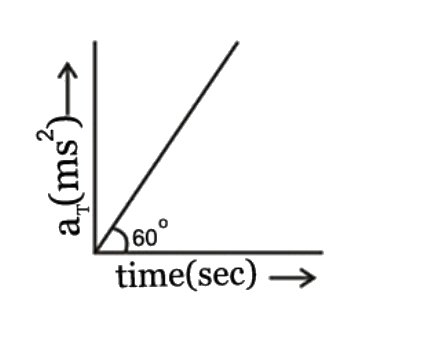The acceleration of a'particle starting from rest, varies with time according to the relation a=kt+c. The velocity of the particle after time t will be :
kt2+12ct
12kt2+ct
12(kt2+c)
kt2+ct
The correct Answer is:B
To solve the problem, we need to find the velocity of a particle whose acceleration varies with time according to the equation a=kt+c, where k and c are constants. The particle starts from rest, which means its initial velocity is zero.
1. Understand the relationship between acceleration and velocity:
- Acceleration is defined as the rate of change of velocity with respect to time. Therefore, we can express this relationship mathematically as:
a=dvdt
2. Substitute the given acceleration equation:
- We know from the problem that:
a=kt+c
- Thus, we can rewrite the equation as:
dvdt=kt+c
3. Integrate both sides:
- To find the velocity v, we need to integrate the acceleration with respect to time t:
v=∫(kt+c)dt
4. Perform the integration:
- The integral can be calculated as follows:
v=∫(kt+c)dt=∫ktdt+∫cdt
- The first integral ∫ktdt gives:
k2t2
- The second integral ∫cdt gives:
ct
- Therefore, combining these results, we have:
v=k2t2+ct+C
- Here, C is the constant of integration.
5. Apply the initial condition:
- Since the particle starts from rest, the initial velocity at t=0 is v(0)=0:
v(0)=k2(0)2+c(0)+C=0⟹C=0
6. Final expression for velocity:
- Thus, the velocity of the particle after time t is:
v=k2t2+ct
Conclusion:
The velocity of the particle after time t is given by:
v=kt22+ct
- Acceleration is defined as the rate of change of velocity with respect to time. Therefore, we can express this relationship mathematically as:
a=dvdt
- We know from the problem that:
a=kt+c
- Thus, we can rewrite the equation as:
dvdt=kt+c
- To find the velocity v, we need to integrate the acceleration with respect to time t:
v=∫(kt+c)dt
- The integral can be calculated as follows:
v=∫(kt+c)dt=∫ktdt+∫cdt
- The first integral ∫ktdt gives:
k2t2
- The second integral ∫cdt gives:
ct
- Therefore, combining these results, we have:
v=k2t2+ct+C
- Here, C is the constant of integration.
- Since the particle starts from rest, the initial velocity at t=0 is v(0)=0:
v(0)=k2(0)2+c(0)+C=0⟹C=0
- Thus, the velocity of the particle after time t is:
v=k2t2+ct
The velocity of the particle after time t is given by:
v=kt22+ct
Similar Questions
The acceleration of a particle which starts from rest varies with time according to relation a=2t+3. The velocity of the particle at time t would be
View SolutionThe acceleration a of a particle starting from rest varies with time according to relation, a=αt+β. Find the velocity of the particle at time instant t.
Strategy : a=dvdt
View Solution
Knowledge Check
The displacement of a particle varies with time according to the relation y=asinωt+bcosωt.
AThe motion is oscillatory but not SHM.BThe motion is SHM with amplitude a+b.CThe motion is SHM with amplitude a2+b2DThe motion is SHM with amplitude √a2+b2.
The acceleration of a particle varies with time t seconds according to the relation a=6t+6ms−2. Find velocity and position as funcitons of time. It is given that the particle starts from origin at t=0 with velocity 2ms−1.
View SolutionStarting from rest, the acceleration of a particle is a=2(t-1). The velocity of the particle at t=5s is :-
View SolutionThe displacement of a particle varies with time according to the relation y=asinωt+bcoasωt.
View SolutionA particle starts from rest and moves with an acceleration of a={2+|t−2|}m/s2 The velocity of the particle at t=4 sec is
View SolutionA particle starts from rest and moves with an acceleration of a={2+|t−2|}m/s2 The velocity of the particle at t=4 sec is
View SolutionThe position x of a particle varies with time t according to the relation x=t3+3t2+2t. Find the velocity and acceleration as functions of time.
View SolutionTangental acceleration of a particle moving in a circle of radius 1 m varies with time t as shown in figure (initial velocity of the particle is zero). Time after which total acceleration of particle makes an angle of 30∘ with radial acceleration is

View Solution
